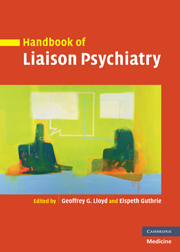Book contents
- Frontmatter
- Contents
- List of contributors
- Preface
- Part I Basic skills
- Part II Common psychiatric problems across the general hospital
- Part III Working with specific units
- Part IV Treatment
- Part V Different treatment settings
- 36 Developing links with primary care
- 37 Frequent attenders in primary care
- 38 Major disaster planning
- Index
- References
37 - Frequent attenders in primary care
from Part V - Different treatment settings
Published online by Cambridge University Press: 10 December 2009
- Frontmatter
- Contents
- List of contributors
- Preface
- Part I Basic skills
- Part II Common psychiatric problems across the general hospital
- Part III Working with specific units
- Part IV Treatment
- Part V Different treatment settings
- 36 Developing links with primary care
- 37 Frequent attenders in primary care
- 38 Major disaster planning
- Index
- References
Summary
Introduction
Why do people consult their doctors? Some individuals never consult medical practitioners while others consult unusually frequently. A number of factors contribute to patients' help-seeking behaviour (Campbell & Roland 1996; Gill & Sharpe 1999). Organizational factors such as distance from the surgery, the appointment system and access to other healthcare facilities may influence the decision to seek care. Doctor-related factors are also likely to be important. For instance, there is evidence that some doctors appear to attract a disproportionate number of frequently attending patients, and it is possible that some doctors actively encourage frequent attendance (Neal et al. 2000a). This chapter reviews the patient factors associated with frequent attendance in primary care and suggests strategies for managing patients who attend unusually frequently.
Concepts and definitions
There are two conceptual issues which have important implications for the interpretation of research findings.
The first concerns the concept of ‘a consultation’. There is no standard definition. Different approaches include defining consultations as entries in primary care notes or computerized records, contact with any member of the primary-care team, or face-to-face consultation with a general practitioner. Some studies have included only patient-initiated consultations. Others have excluded attendance for ‘routine’ reasons such as contraception and pregnancy. Home visits have been counted as consultations in some studies but not in others.
The second issue is more complex and concerns the definition of ‘frequent consultation’. Three main approaches have been adopted in the literature.
Keywords
- Type
- Chapter
- Information
- Handbook of Liaison Psychiatry , pp. 871 - 895Publisher: Cambridge University PressPrint publication year: 2007



